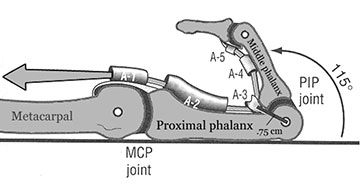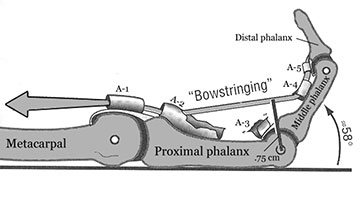Flexor Pulleys of the Fingers
- Whitney Lowe
The human hand represents one of nature’s most sophisticated biomechanical designs. As massage practitioners, we rely on our hands for every aspect of our work, yet rarely consider the intricate systems that enable their function. The hand’s ability to perform both precise movements and powerful gripping actions stems from an elegant combination of skeletal structure and muscular control, facilitated by a remarkable mechanical system: the flexor pulleys.
The flexor pulleys form a complex biomechanical system that maximizes the efficiency of finger movement. These specialized connective tissue structures anchor the flexor tendons close to the finger bones, creating a mechanical advantage that enables both precise control and powerful force generation. Without this system, our ability to perform detailed movements would be severely compromised, and the force-generating capacity of our fingers would be significantly reduced.
The system consists of two types of pulleys: annular and cruciate. The five annular pulleys, designated A1 through A5, form strong fibrous bands that encircle the flexor tendons (Figure 1).

Their positioning is strategically important, with the A1, A3, and A5 pulleys located at the metacarpophalangeal (MCP), proximal interphalangeal (PIP), and distal interphalangeal (DIP) joints respectively. The A2 and A4 pulleys, considered the major pulleys, are positioned along the proximal and middle phalanges and are crucial for preventing tendon bowstringing during finger flexion (Figure 2).

The cruciate (cross-shaped) pulleys provide additional support between the annular pulleys. These smaller structures, designated C1, C2, and C3, offer supplementary stability to the tendon sheath while allowing for necessary flexibility during finger movement. While the cruciate pulleys play a less prominent role in preventing bowstringing, they contribute significantly to the overall smooth function of the finger flexion mechanism.
Damage to the flexor pulleys can significantly impair hand function. Acute ruptures most frequently affect rock climbers due to extreme forces on partially flexed fingers, with the A2 pulley being particularly vulnerable. When a pulley ruptures, it results in the characteristic “bowstringing” effect where the flexor tendon lifts away from the bone, significantly reducing grip strength and finger control Figure 3.

Another common condition affecting the pulley system is stenosing tenosynovitis, commonly known as trigger finger. This condition involves thickening of the tendon sheath near the A1 pulley, creating mechanical catching or locking during finger flexion. In severe cases, surgical release of the A1 pulley may be necessary to restore normal finger movement.
Understanding the flexor pulley system is crucial for massage practitioners for several reasons. First, it helps us protect our own hands during practice. Recognition of early warning signs of pulley stress, implementation of proper body mechanics, and understanding load management during deep tissue work are essential for career longevity. Second, this knowledge enhances our clinical assessment skills, enabling us to recognize symptoms of pulley dysfunction in clients and understand how such injuries might affect their occupational activities.
While massage practitioners may not directly treat pulley injuries, awareness of this system informs our approach to client education and treatment modification. We can teach clients about proper hand positioning during daily activities, help them recognize early warning signs of dysfunction, and provide prevention strategies for repetitive stress. Additionally, this knowledge allows us to adapt our treatment approaches for clients with pulley injuries, understand grip strength limitations in affected clients, and recognize contraindications for certain techniques.
As manual therapy practitioners, protecting our hands is crucial for career longevity. Proper body mechanics include avoiding excessive finger flexion during deep pressure, using broader contact surfaces when appropriate, and maintaining optimal wrist positioning. Equally important is work load management through appropriate spacing of deep tissue sessions, regular breaks between clients, and gradual progression of force application.
The flexor pulley system exemplifies the remarkable engineering of human anatomy. For massage practitioners, understanding this system goes beyond academic interest – it directly impacts our ability to work effectively and maintain career longevity. By appreciating the complexity and vulnerability of this system, we can better protect our most valuable tools while providing more informed care to our clients. Most importantly, this knowledge helps us maintain the health and function of our hands throughout our careers, ensuring we can continue to provide effective care for our clients.

